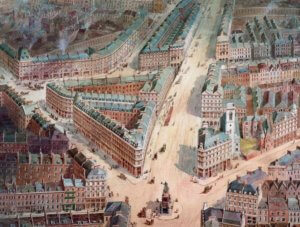Hatton Garden was developed as a stylish residential area during the reign of King Charles II. Now known as a commercial area in Holborn with many fine jewelry and diamond shops, during the Regency it was a respectable address and also an area for light industrial businesses, including jewelry makers. Italian craftsmen flocked to the area, as well as gold refiners. In addition, One of the Rotchschild’s, who would have significant diamond mines, had a home in Hatton Garden. (Hatton Garden – The Diamond Trust) This helped usher in Hatton Garden’s new identity.













Looking a the photo as best I could, I am wondering if the term ‘Garden’ referred to the secluded areas created by the structure of the buildings around the irregular shapes made by the streets criss-crossing through the neighborhood. Each set of buildings has what looks like a large shared courtyard like area behind the homes/businesses. Otherwise I don’t see a specific garden anywhere.
Its name derives from Hatton, who lived in Ely Palace which had a garden that belonged to the Bishops. Upon his death, his family had to sell off the garden to pay debts. I think it was a “garden” in memory only.